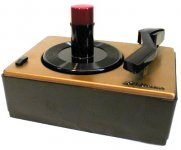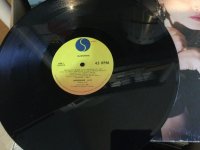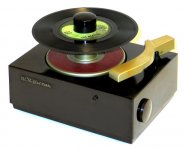All the singles I own or have ever seen have the original centre retained by tabs so it could be popped out, unless it had already been popped out coming from a jukebox.
Once popped out the centre could not be reused. If you required the small hole you used one of the sprung adaptors seen in PRRs picture.
Never seen an autochanger with a large spindle, only the small spindle with steadying arm.
Some had a mechanical switch to select the diameter (12, 10 or 7"), my parents had an Alba stereo record console with Garrard TT, it had an additional arm that measured the record diameter as it fell. When I wanted to repeat play the latest single I had to prop the arm with a matchstick or the stylus would fall as for a 12".
Once popped out the centre could not be reused. If you required the small hole you used one of the sprung adaptors seen in PRRs picture.
Never seen an autochanger with a large spindle, only the small spindle with steadying arm.
Some had a mechanical switch to select the diameter (12, 10 or 7"), my parents had an Alba stereo record console with Garrard TT, it had an additional arm that measured the record diameter as it fell. When I wanted to repeat play the latest single I had to prop the arm with a matchstick or the stylus would fall as for a 12".
Not having to incorporate a stabilizing arm was one of the prime reasons for the large diameter, the large spindle had two opposing 'one-way' tabs that would release record after record. The spindle had a mark of such to indicate the maximum stack one could run. When removing the ten or so 45s , the mechanism would make a ratchet sound as you drew off the stack.
-------------------------------------------------------------------------Rick........
-------------------------------------------------------------------------Rick........
Attachments
Pop out Centers on 45s
I have about 20 45s from various makers including RCA, Capital, Colossis, Belter, Motown, Decca, and that all time classic "Complete Crow Calling Record" one and two. Most look like they originally had pop-out centers like this one.
I have about 20 45s from various makers including RCA, Capital, Colossis, Belter, Motown, Decca, and that all time classic "Complete Crow Calling Record" one and two. Most look like they originally had pop-out centers like this one.
Attachments
About 2 decades (or was it 3) later, the market was flooded with 45 RPM records with a small spindle hole. Still have a lot of them.
Many of them played at 33, though.
I always hated spinning with 7” singles - if it was the only copy I had, I had to play it. By that time you couldn’t get a good pressing on a 7” 45 to save your soul.
Many of them played at 33, though.
I always hated spinning with 7” singles - if it was the only copy I had, I had to play it. By that time you couldn’t get a good pressing on a 7” 45 to save your soul.
Attachments
The radio / TV repairman next door gave me a wood RCA portable 45 changer with a tube amp that had a pretty big OPT. Lotsa bass as I recall. Probably was a 7-HF-45
I don't see the VTA adjustment screw at the arm baseThe spindle had a mark of such to indicate the maximum stack one could run. When removing the ten or so 45s , the mechanism would make a ratchet sound as you drew off the stack.

There are a couple near my turntable because I still have a few 7 inch 45's. I also have one or two 10 inch 45 RPM EP's. They have the small hole.
I had a yellow plastic 45 adapter on the dash tray in my car when I worked with a group of people much younger than me. When someone would ask what it was, I would reply that it was an old age test, and you failed.
After several years of this people began to recognize it as a piece of jewelry. Apparently a popular female singer used to wear a gold or chrome plated version on a chain around her neck at her shows. Whoever it was, I didn't recognize her name, so I failed the young age test.
I had a yellow plastic 45 adapter on the dash tray in my car when I worked with a group of people much younger than me. When someone would ask what it was, I would reply that it was an old age test, and you failed.
After several years of this people began to recognize it as a piece of jewelry. Apparently a popular female singer used to wear a gold or chrome plated version on a chain around her neck at her shows. Whoever it was, I didn't recognize her name, so I failed the young age test.
RCA invented the 45 as a complete system with *changer*. That's why the monster hole: all the contraption was inside the spindle, no overhead arm to steady the stack. It gave quality potentially comparable to LP at price similar to one 78, ideal for "singles". But also possible to program longer works on multiple discs, like 78s.
In my collection I've got several of those little RCA Victor mini-changers.
The 45J/RP168 (first introduced in 1949) and two RP190's.
With a little bit of sensible modifications, they perform quite nicely.
Attachments
Last edited:
I never was once one for 7" singles, or jukeboxes, but have seen plenty of these on Shadows records (that whole era)
These were necessary purely because of jukeboxes? I have a few decks and never have I had one without centre spindle.
And I'm younger than the test would have you believe hahah.
These were necessary purely because of jukeboxes? I have a few decks and never have I had one without centre spindle.
And I'm younger than the test would have you believe hahah.
RCA invented the 45 as a complete system with *changer*.... It gave quality potentially comparable to LP at price similar to one 78, ideal for "singles".
By the time I had money to buy singles in the mid/late 70’s the quality had gone to hell in a hand basket. By the 80’s they were completely unlistenable.
There are a couple near my turntable because I still have a few 7 inch 45's. I also have one or two 10 inch 45 RPM EP's. They have the small hole. .
I had a couple 10l” but most of mine were 12”. They actually sounded GOOD and made a Stanton 500 put out 20-some-odd millivolts compare to the rated 5. And no problems mistracking or wearing out in 100+ plays.
...These were necessary purely because of jukeboxes? ...
Nothing to do with jukeboxes. Get off my lawn!!
Um...sorry....
Maybe irrelevant, but IMHO vinyl really opened up many of the things we ALL still love, (I think) such as the "Album band".
Those bands, that made great albums - regardless if they were a singles market success or not.
The Stones, Queen, Floyd, Mike Oldfield.
Indeed many of the greats my father's generation loved and indeed created, but who grew up with a more hit single orientated market.
Today again, we have gone full cycle.
This interested me. I'm sorry if I offended by being on the lawn
Funniest fact of all...
My DIYA password was inspired by an artist of the early singles era.
Go figure.
10" EP I had was excellent, and I think that was a 45.
In modern times, white label presses, I had many 12" 45s, as is quite common with DJing.
On a vinyl tip.
So to speak
Maybe irrelevant, but IMHO vinyl really opened up many of the things we ALL still love, (I think) such as the "Album band".
Those bands, that made great albums - regardless if they were a singles market success or not.
The Stones, Queen, Floyd, Mike Oldfield.
Indeed many of the greats my father's generation loved and indeed created, but who grew up with a more hit single orientated market.
Today again, we have gone full cycle.
This interested me. I'm sorry if I offended by being on the lawn
Funniest fact of all...
My DIYA password was inspired by an artist of the early singles era.
Go figure.
10" EP I had was excellent, and I think that was a 45.
In modern times, white label presses, I had many 12" 45s, as is quite common with DJing.
On a vinyl tip.
So to speak
Last edited:
By the time I had money to buy singles in the mid/late 70’s the quality had gone to hell in a hand basket. By the 80’s they were completely unlistenable.
I had a couple 10l” but most of mine were 12”. They actually sounded GOOD and made a Stanton 500 put out 20-some-odd millivolts compare to the rated 5. And no problems mistracking or wearing out in 100+ plays.
With those 12" 45's, back in the disco era, they were touted as being higher fidelity-higher definition due to the increased speed.
Which they were - I've got some and can confirm that fact.
The faster speed allowed more groove to pass under the stylus, same as a faster reel to reel tape has extended frequency response.
Italian 45s like the ones sold in the U.S. all had the large hole, I later discovered this was not universally true, finding disks in the UK and Germany that had the standard sized hole.
I had no idea what they were and not because of age. Because 45's sold in Australia had exactly the same centers as 33's.....
Tony.
Back in my youth Frito-Lays used to sell Fritos with a 45 RPM single attached to the package. I still remember my very first real "record." It was a 45 RPM single from the grocery store on a bag of Fritos, 'Every Day I Have To Cry" by Steve Alaimo, a radio hit in 1963. I collected most of the "free" Fritos 45's.
Coincidentally Steve Alaimo lived in Miami and ran a second rate recording studio after his music and TV career had ended. I went there a couple times to get some of their cast off equipment for the third rate studio where I did some part time work making commercial cartridges for WEDR, the "underground Miami" radio station. Steve's recording studio would go big time when Latin Disco exploded with KC and the sunshine band, then fade just as fast when disco died.
In another coincidence, I would wind up working with Steve's brother, Joe a maintenance tech at Motorola several years later.
Coincidentally Steve Alaimo lived in Miami and ran a second rate recording studio after his music and TV career had ended. I went there a couple times to get some of their cast off equipment for the third rate studio where I did some part time work making commercial cartridges for WEDR, the "underground Miami" radio station. Steve's recording studio would go big time when Latin Disco exploded with KC and the sunshine band, then fade just as fast when disco died.
In another coincidence, I would wind up working with Steve's brother, Joe a maintenance tech at Motorola several years later.
Every 45 I ever owned in the US had the large center hole. I had various changers and the ones that had a fixed small spindle came with a fat changer spindle that you just slipped over the top of the skinny one. I always wondered about that until I went to live in UK. I went into a record shop and wondered what was going on with the little holes in 45s until the owner said just pop it out if you need to. That was early in my education of the world outside the US.
- Home
- Member Areas
- The Lounge
- age test




